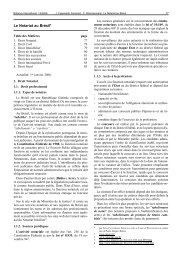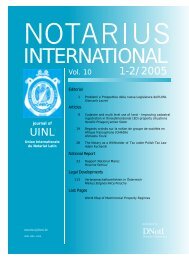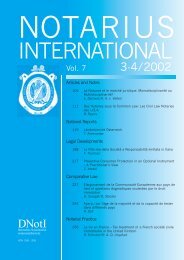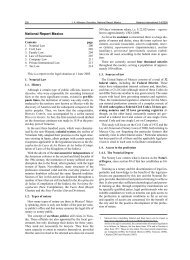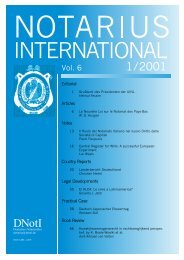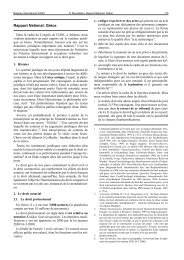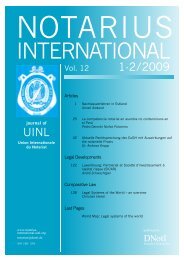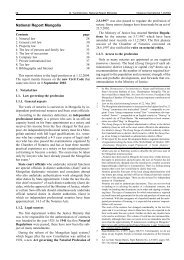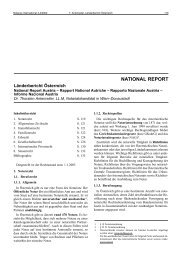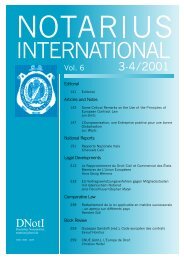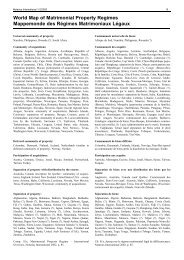Create successful ePaper yourself
Turn your PDF publications into a flip-book with our unique Google optimized e-Paper software.
<strong>Notarius</strong> <strong>International</strong> 3-4/<strong>2005</strong> J. A. Márquez González, National Report Mexico 203<br />
are voluntarily affiliated to this body and it also includes,<br />
in accordance with its statutes, the Presidents of the local<br />
notarial Associations and Councils throughout the country,<br />
which means that it is highly representative at a national<br />
level, although it is true that not all notaries are affiliated<br />
to it.<br />
2. Civil Law<br />
2.1. Civil law in general<br />
The Código Civil del Distrito Federal (CCDF) [Civil<br />
Code of the Federal District (CCFD)] has been in force<br />
since 1932 and has been subject to considerable changes<br />
in recent years. It continues to be profoundly influenced<br />
by the Napoleonic code of 1804 and is, in general, structured<br />
in quite a similar way.<br />
All the codes in the Republic are very similar, but that<br />
does not mean that there are no differences between<br />
them. Some of those differences are quite significant.<br />
For example, most of the codes contemplate the doctrine<br />
of “legal act”. In fact, articles 1792, 1973 and 1859<br />
of the CCFD contain the definitions of agreement and<br />
contract, obeying in this regard the French theory enshrined<br />
in the Code of Napoleon. Nevertheless, some<br />
codes differ from this system of doctrine. This is the case<br />
with the civil codes of Quintana Roo (articles 135-425),<br />
Coahuila (articles 1899-2198) and Guerrero (articles<br />
1593 et seqq.), which adhere to the theory of “legal business”.<br />
The oldest civil codes in the country are those of Veracruz<br />
(1932), Nuevo León (1935), Michoacán (1936),<br />
Chiapas (1938), Hidalgo and Sinaloa (1940), Campeche<br />
and Oaxaca (1943), San Luis Potosí (1946), Aguascalientes<br />
(1947), Durango (1948), Sonora (1949), Colima<br />
(1953), Guanajuato (1967), Baja California and Chihuahua<br />
(1974) and Tlaxcala (1976). The newest are those of<br />
Quintana Roo (1980), Nayarit (1981), Puebla (1985), Zacatecas<br />
(1986), Tamaulipas (1987), Querétaro (1990),<br />
Guerrero and Yucatán (1993), Morelos (1994), Jalisco<br />
(1995), Baja California Sur (1996), Tabasco (1997), Coahuila<br />
(1999) and, finally, Estado de México (2002).<br />
2.2. Property law<br />
Book Two of the CCFD deals extensively with possession,<br />
ownership, usufruct, use, habitation and easement<br />
and is not until the Second Part (Various types of contract)<br />
of Book Four (Obligations) that it examines the alienation<br />
of immovable property in each of the specific<br />
contracts in question.<br />
In our law, the contract of purchase and sale is consensual.<br />
In fact, in accordance with the provision contained<br />
in article 2248, “A purchase and sale will exist when one<br />
of the parties to the contract agrees to transfer the ownership<br />
of a thing or a right and the other party, in turn,<br />
agrees to pay a certain price for them in money”. In general,<br />
the sale is perfected when the parties have agreed on<br />
the considerations, even though these may not yet have<br />
been physically delivered.<br />
2.3. Alienation of immovable property<br />
2.3.1. Requirements in terms of form<br />
A contract of purchase and sale is required to adopt a<br />
certain specific form when it deals with real estate properties.<br />
The CCFD provides that alienations up to the value<br />
of 365 times the minimum general daily salary of<br />
Mexico City (approximately $ 16,100 pesos, equivalent<br />
to approximately USD 1,500) may be carried out in a private<br />
document before two witnesses, with the signatures<br />
being confirmed before a notary, a judge or a registrar.<br />
This is also the case with operations of creation of transfer<br />
of real rights for the same sum. Contracts relating to<br />
alienations carried out by the government for poor people<br />
may, on the other hand, dispense with the witnesses and<br />
the certification of signatures. It should be clarified that<br />
these social-interest contracts are almost always granted<br />
a 50% reduction of the tariff. All contracts that exceed<br />
that amount of USD 1,500 must be executed in a public<br />
deed before a notary.<br />
2.3.2. Execution in a public deed<br />
To sum up, the procedure for executing a public deed<br />
may be summarised as follows:<br />
- First, the notary is obliged to obtain a certificate from<br />
the public registry office relating to the existence or<br />
otherwise of encumbrances in connection with the<br />
property to which the transfer relates.<br />
- This request also serves as a preventive notice in which<br />
the disclosed transaction is mentioned. The registrar issues<br />
a note of submission, which is valid for 30 calendar<br />
days.<br />
- When the deed has been signed, another preventive<br />
notice is issued by the notary, but now with the addition<br />
of the date of the deed and its signature.<br />
- The notary must then continue with the procedure of<br />
payment of fees and taxes relating to the transaction in<br />
question and when they have all been paid, he must issue<br />
the respective transcript for its final entry on the<br />
public register.<br />
2.3.3. Entry on the register<br />
The institution of registration operates according to<br />
the principles of public recording, entry, speciality, consent,<br />
successive intervals, request, priority, legality and<br />
presumption of accuracy of the register.<br />
Article 3042 of the CCFD states that the following acts<br />
must be registered:<br />
- Titles whereby dominion, original possession and other<br />
real rights on immovable property are created, declared,<br />
recognised, acquired, transferred, amended,<br />
restricted, encumbered or extinguished;<br />
- The creation of family property;<br />
- Contracts for lease of immovable property for a period<br />
of over six years and leases in which more than<br />
three years' rent is paid in advance; and<br />
4 Internet: www.notariadomexicano.org.mx/



